Abstract
OBJECTIVE--To determine the prognosis and adverse prognostic factors in patients with retinal infarction due to presumed atheromatous thromboembolism or cardiogenic embolism. DESIGN--Prospective cohort study. SETTING--University hospital departments of clinical neurology. PATIENTS--99 patients with retinal infarction, without prior stroke, referred to a single neurologist between 1976 and 1986 and evaluated and followed up prospectively until death or the end of 1986 (mean follow up 4.2 years). INTERVENTIONS--Cerebral angiography (55 patients), aspirin treatment (37), oral anticoagulant treatment (eight), carotid endarterectomy (13), cardiac surgery (six), and peripheral vascular surgery (two). MAIN OUTCOME MEASURES--Death, stroke, coronary events, contralateral retinal infarction; survival analysis confined to 98 patients with retinal infarction due to presumed artheromatous thromboembolism or cardiogenic embolism (one patient with giant cell arteries excluded), and Cox's proportional hazards regression analysis, including age as a prognostic factor. RESULTS--During follow up 29 patients died (21 of vascular causes and eight of non-vascular or unknown causes), 10 had a first ever stroke, 19 had a coronary event, and only one developed contralateral retinal infarction. A coronary event accounted for more than half (59%) of the deaths whereas stroke was the cause of only one death (3%). Over the first five years after retinal infarction the actuarial average absolute risk of death was 8% per year; of stroke 2.5% per year (7.4% in the first year); of coronary events 5.3% per year, exceeding that of stroke; and of stroke, myocardial infarction, or vascular death 7.4% per year. Prognostic factors associated with an increased risk of death were increasing age, peripheral vascular disease, cardiomegaly, and carotid bruit. Adverse prognostic factors for serious vascular events were increasing age and carotid bruit for stroke, and increasing age, cardiomegaly, and carotid bruit both for coronary events and for stroke, myocardial infarction, or vascular death. CONCLUSIONS--Patients who present with retinal infarction due to presumed atherothromboembolism or cardiogenic embolism are at considerable risk of a coronary event. The risk of stroke, although high, is not so great. Not all strokes occurring after retinal infarction relate directly to disease of the ipsilateral carotid system, although this is probably the most common cause. Few patients experience contralateral retinal infarction. Non-arteritic retinal infarction should be diagnosed or confirmed by an ophthalmologist, and the long term care of patients with the condition should involve a physician who has an active interest in managing vascular disease.
Full text
PDF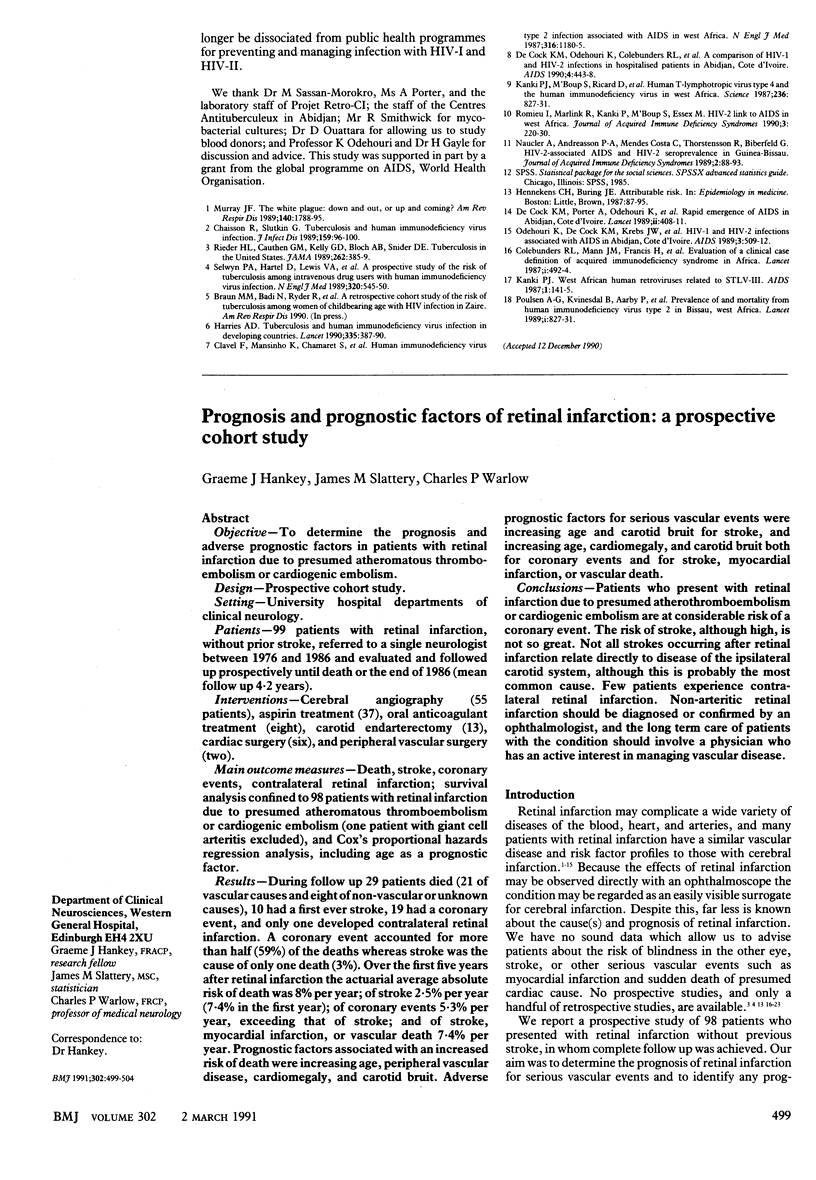

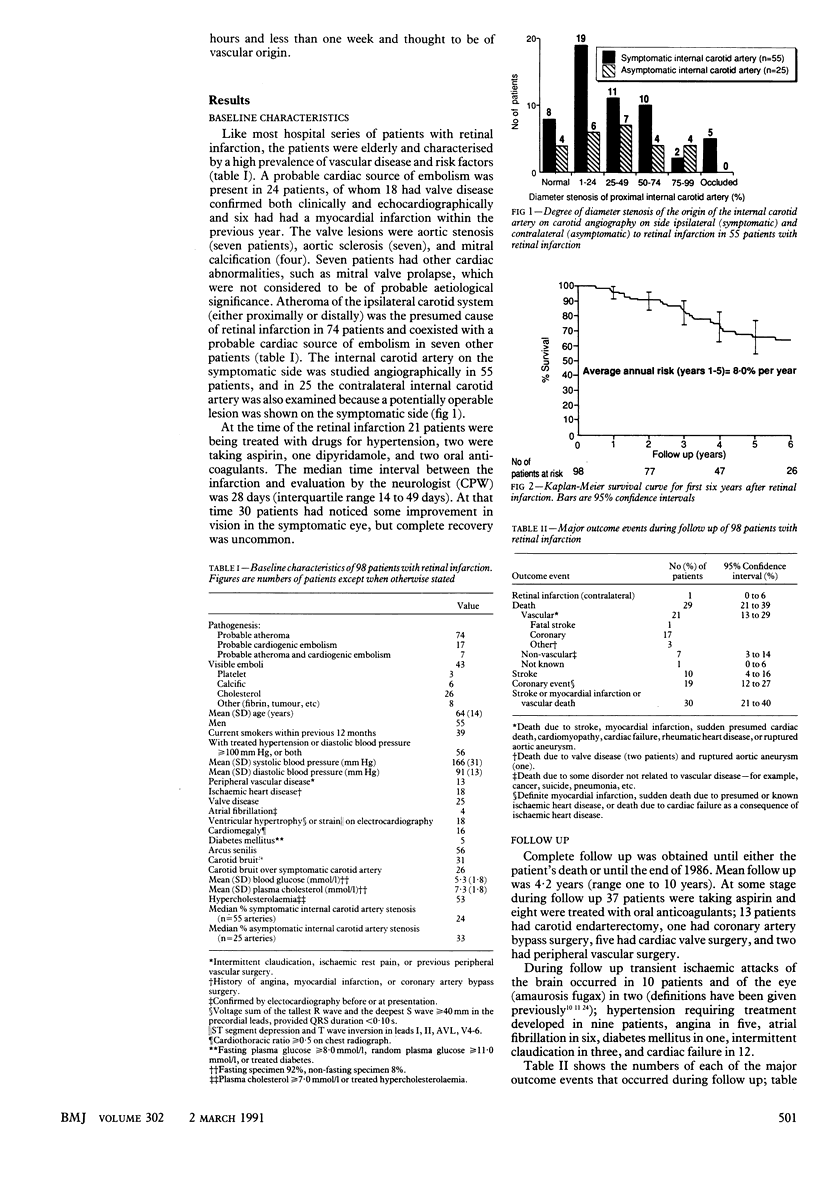
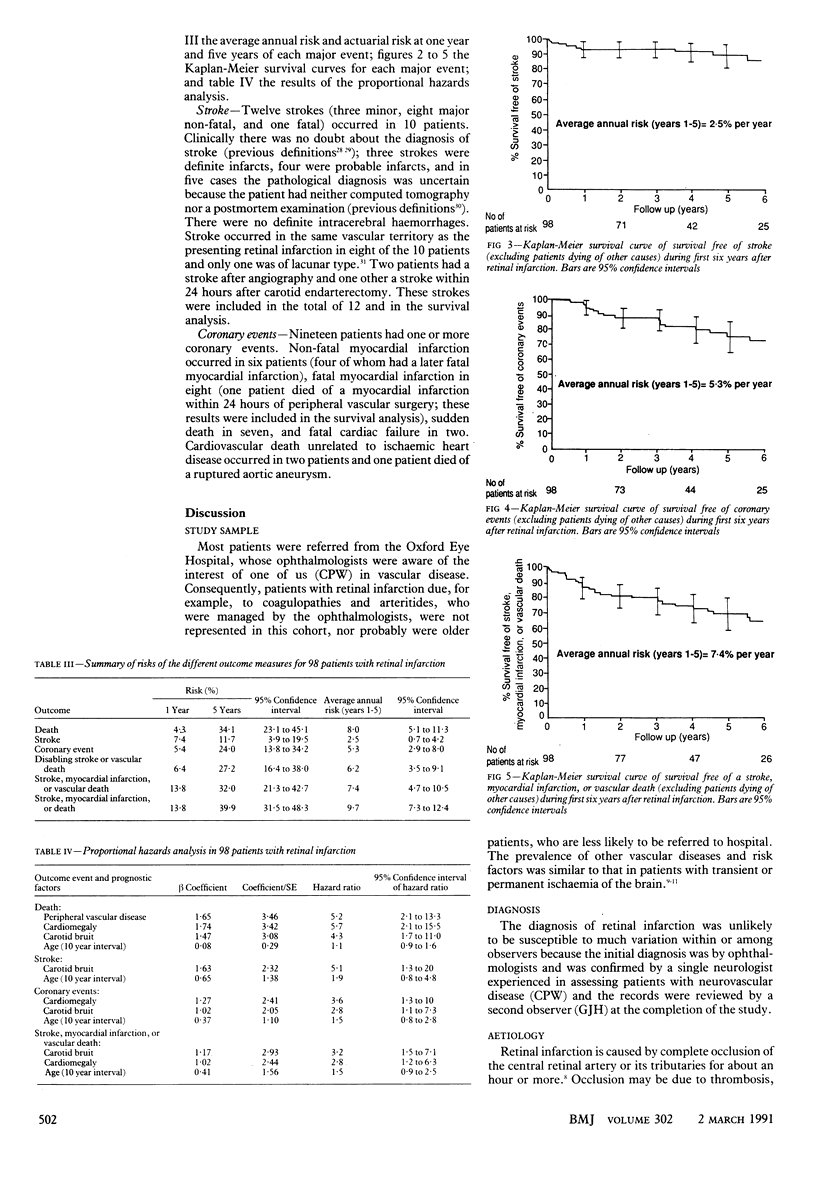
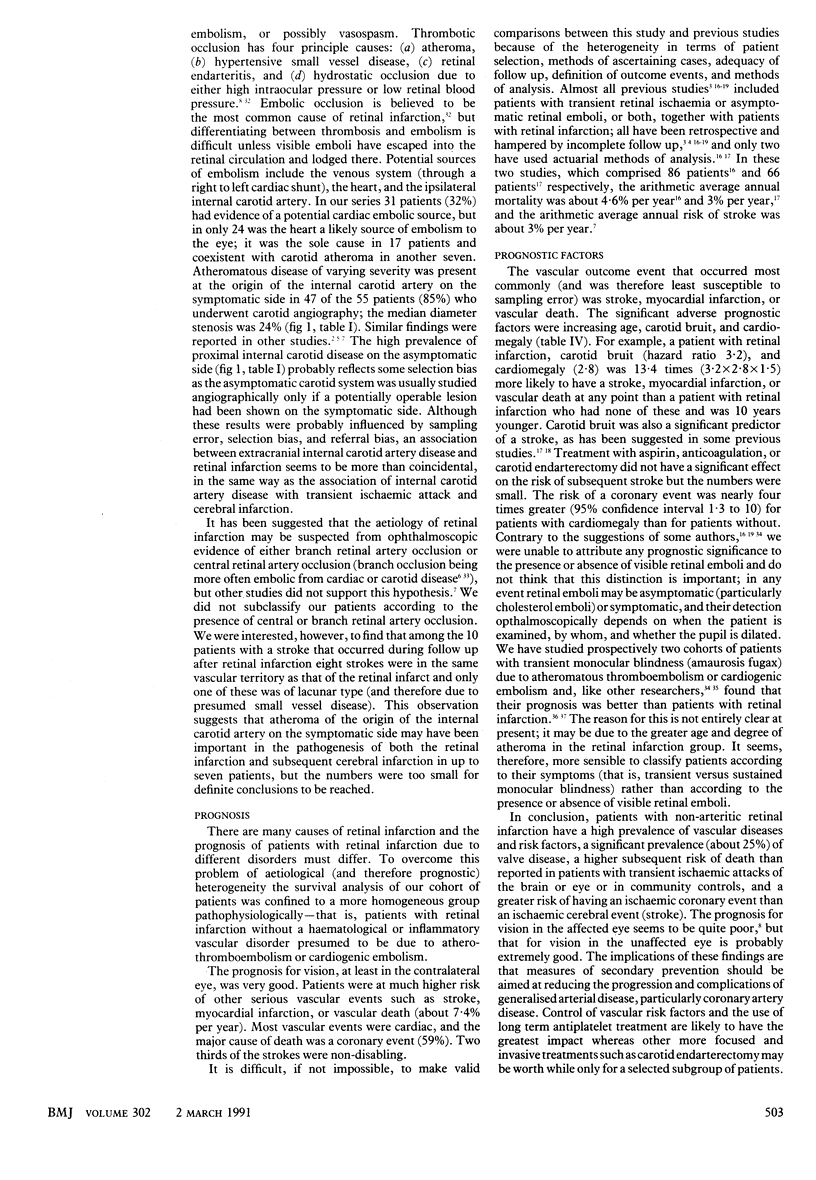
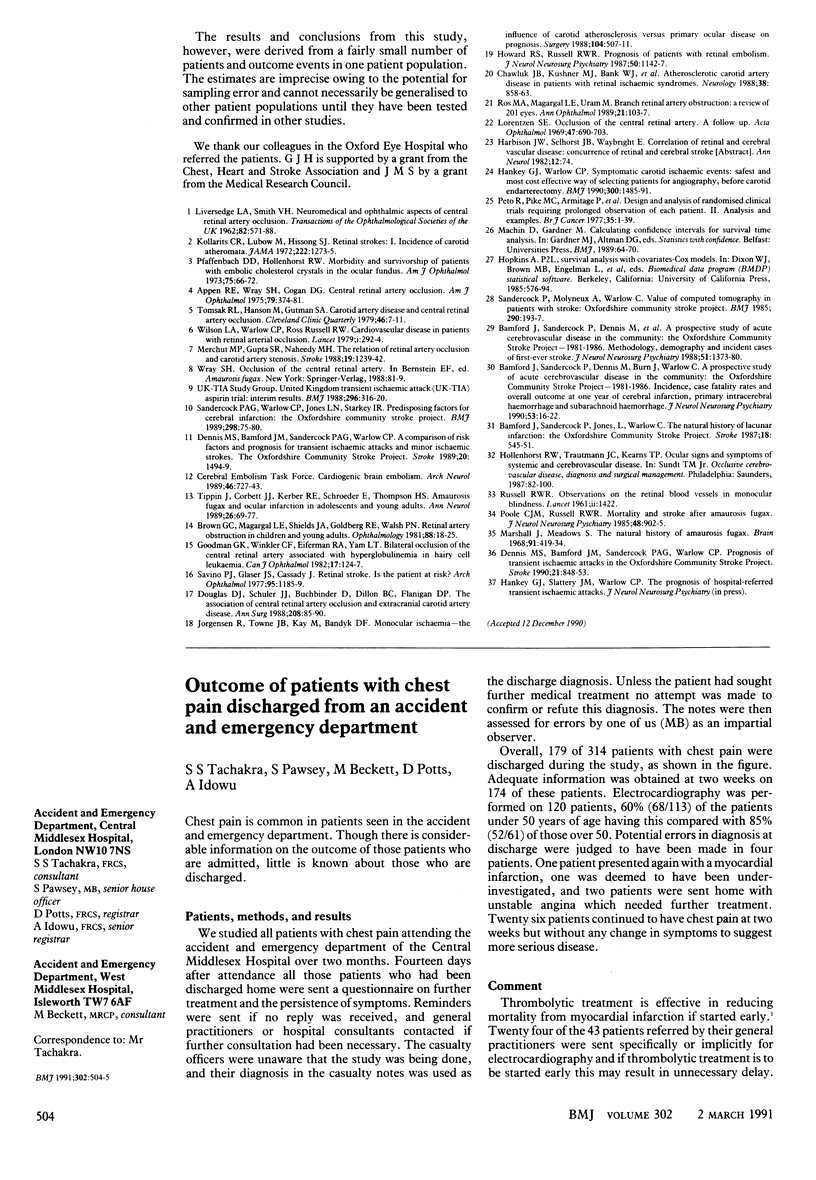
Selected References
These references are in PubMed. This may not be the complete list of references from this article.
- Appen R. E., Wray S. H., Cogan D. G. Central retinal artery occlusion. Am J Ophthalmol. 1975 Mar;79(3):374–381. doi: 10.1016/0002-9394(75)90609-1. [DOI] [PubMed] [Google Scholar]
- Bamford J., Sandercock P., Dennis M., Burn J., Warlow C. A prospective study of acute cerebrovascular disease in the community: the Oxfordshire Community Stroke Project--1981-86. 2. Incidence, case fatality rates and overall outcome at one year of cerebral infarction, primary intracerebral and subarachnoid haemorrhage. J Neurol Neurosurg Psychiatry. 1990 Jan;53(1):16–22. doi: 10.1136/jnnp.53.1.16. [DOI] [PMC free article] [PubMed] [Google Scholar]
- Bamford J., Sandercock P., Dennis M., Warlow C., Jones L., McPherson K., Vessey M., Fowler G., Molyneux A., Hughes T. A prospective study of acute cerebrovascular disease in the community: the Oxfordshire Community Stroke Project 1981-86. 1. Methodology, demography and incident cases of first-ever stroke. J Neurol Neurosurg Psychiatry. 1988 Nov;51(11):1373–1380. doi: 10.1136/jnnp.51.11.1373. [DOI] [PMC free article] [PubMed] [Google Scholar]
- Bamford J., Sandercock P., Jones L., Warlow C. The natural history of lacunar infarction: the Oxfordshire Community Stroke Project. Stroke. 1987 May-Jun;18(3):545–551. doi: 10.1161/01.str.18.3.545. [DOI] [PubMed] [Google Scholar]
- Brown G. C., Magargal L. E., Shields J. A., Goldberg R. E., Walsh P. N. Retinal arterial obstruction in children and young adults. Ophthalmology. 1981 Jan;88(1):18–25. doi: 10.1016/s0161-6420(81)35080-5. [DOI] [PubMed] [Google Scholar]
- Chawluk J. B., Kushner M. J., Bank W. J., Silver F. L., Jamieson D. G., Bosley T. M., Conway D. J., Cohen D., Savino P. J. Atherosclerotic carotid artery disease in patients with retinal ischemic syndromes. Neurology. 1988 Jun;38(6):858–863. doi: 10.1212/wnl.38.6.858. [DOI] [PubMed] [Google Scholar]
- Dennis M. S., Bamford J. M., Sandercock P. A., Warlow C. P. A comparison of risk factors and prognosis for transient ischemic attacks and minor ischemic strokes. The Oxfordshire Community Stroke Project. Stroke. 1989 Nov;20(11):1494–1499. doi: 10.1161/01.str.20.11.1494. [DOI] [PubMed] [Google Scholar]
- Dennis M., Bamford J., Sandercock P., Warlow C. Prognosis of transient ischemic attacks in the Oxfordshire Community Stroke Project. Stroke. 1990 Jun;21(6):848–853. doi: 10.1161/01.str.21.6.848. [DOI] [PubMed] [Google Scholar]
- Douglas D. J., Schuler J. J., Buchbinder D., Dillon B. C., Flanigan D. P. The association of central retinal artery occlusion and extracranial carotid artery disease. Ann Surg. 1988 Jul;208(1):85–90. doi: 10.1097/00000658-198807000-00012. [DOI] [PMC free article] [PubMed] [Google Scholar]
- Goodman G. K., Winkler C. F., Eiferman R. A., Yam L. T. Bilateral occlusion of the central retinal artery associated with hyperglobulinemia in hairy cell leukemia. Can J Ophthalmol. 1982 Jun;17(3):124–127. [PubMed] [Google Scholar]
- Hankey G. J., Warlow C. P. Symptomatic carotid ischaemic events: safest and most cost effective way of selecting patients for angiography, before carotid endarterectomy. BMJ. 1990 Jun 9;300(6738):1485–1491. doi: 10.1136/bmj.300.6738.1485. [DOI] [PMC free article] [PubMed] [Google Scholar]
- Howard R. S., Russell R. W. Prognosis of patients with retinal embolism. J Neurol Neurosurg Psychiatry. 1987 Sep;50(9):1142–1147. doi: 10.1136/jnnp.50.9.1142. [DOI] [PMC free article] [PubMed] [Google Scholar]
- Jorgensen R., Towne J. B., Kay M., Bandyk D. F. Monocular ischemia--the influence of carotid atherosclerosis versus primary ocular disease on prognosis. Surgery. 1988 Sep;104(3):507–511. [PubMed] [Google Scholar]
- Kollarits C. R., Lubow M., Hissong S. L. Retinal strokes. I. Incidence of carotid atheromata. JAMA. 1972 Dec 4;222(10):1273–1275. doi: 10.1001/jama.222.10.1273. [DOI] [PubMed] [Google Scholar]
- LIVERSEDGE L. A., SMITH V. H. Neuromedical and ophthalmic aspects of central retinal artery occlusion. Trans Ophthalmol Soc U K. 1962;82:571–588. [PubMed] [Google Scholar]
- Lorentzen S. E. Occlusion of the central retinal artery. A follow-up. Acta Ophthalmol (Copenh) 1969;47(3):690–703. doi: 10.1111/j.1755-3768.1969.tb08157.x. [DOI] [PubMed] [Google Scholar]
- Marshall J., Meadows S. The natural history of amaurosis fugax. Brain. 1968 Sep;91(3):419–434. doi: 10.1093/brain/91.3.419. [DOI] [PubMed] [Google Scholar]
- Merchut M. P., Gupta S. R., Naheedy M. H. The relation of retinal artery occlusion and carotid artery stenosis. Stroke. 1988 Oct;19(10):1239–1242. doi: 10.1161/01.str.19.10.1239. [DOI] [PubMed] [Google Scholar]
- Peto R., Pike M. C., Armitage P., Breslow N. E., Cox D. R., Howard S. V., Mantel N., McPherson K., Peto J., Smith P. G. Design and analysis of randomized clinical trials requiring prolonged observation of each patient. II. analysis and examples. Br J Cancer. 1977 Jan;35(1):1–39. doi: 10.1038/bjc.1977.1. [DOI] [PMC free article] [PubMed] [Google Scholar]
- Pfaffenbach D. D., Hollenhorst R. W. Morbidity and survivorship of patients with embolic cholesterol crystals in the ocular fundus. Am J Ophthalmol. 1973 Jan;75(1):66–72. doi: 10.1016/0002-9394(73)90653-3. [DOI] [PubMed] [Google Scholar]
- Poole C. J., Ross Russell R. W. Mortality and stroke after amaurosis fugax. J Neurol Neurosurg Psychiatry. 1985 Sep;48(9):902–905. doi: 10.1136/jnnp.48.9.902. [DOI] [PMC free article] [PubMed] [Google Scholar]
- RUSSELL R. W. Observations on the retinal blood-vessels in monocular blindness. Lancet. 1961 Dec 30;2(7218):1422–1428. doi: 10.1016/s0140-6736(61)91247-8. [DOI] [PubMed] [Google Scholar]
- Ros M. A., Magargal L. E., Uram M. Branch retinal-artery obstruction: a review of 201 eyes. Ann Ophthalmol. 1989 Mar;21(3):103–107. [PubMed] [Google Scholar]
- Sandercock P. A., Warlow C. P., Jones L. N., Starkey I. R. Predisposing factors for cerebral infarction: the Oxfordshire community stroke project. BMJ. 1989 Jan 14;298(6666):75–80. doi: 10.1136/bmj.298.6666.75. [DOI] [PMC free article] [PubMed] [Google Scholar]
- Sandercock P., Molyneux A., Warlow C. Value of computed tomography in patients with stroke: Oxfordshire Community Stroke Project. Br Med J (Clin Res Ed) 1985 Jan 19;290(6463):193–197. doi: 10.1136/bmj.290.6463.193. [DOI] [PMC free article] [PubMed] [Google Scholar]
- Savino P. J., Glaser J. S., Cassady J. Retinal stroke. Is the patient at risk? Arch Ophthalmol. 1977 Jul;95(7):1185–1189. doi: 10.1001/archopht.1977.04450070083005. [DOI] [PubMed] [Google Scholar]
- Tippin J., Corbett J. J., Kerber R. E., Schroeder E., Thompson H. S. Amaurosis fugax and ocular infarction in adolescents and young adults. Ann Neurol. 1989 Jul;26(1):69–77. doi: 10.1002/ana.410260111. [DOI] [PubMed] [Google Scholar]
- Tomsak R. L., Hanson M., Gutman F. A. Carotid artery disease and central retinal artery occlusion. Cleve Clin Q. 1979 Spring;46(1):7–11. doi: 10.3949/ccjm.46.1.7. [DOI] [PubMed] [Google Scholar]
- Wilson L. A., Warlow C. P., Russell R. W. Cardiovascular disease in patients with retinal arterial occlusion. Lancet. 1979 Feb 10;1(8111):292–294. doi: 10.1016/s0140-6736(79)90704-9. [DOI] [PubMed] [Google Scholar]


